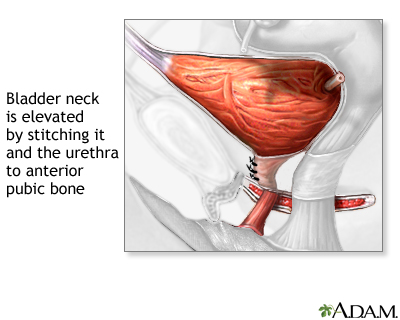
Overview
While the patient is deep asleep and pain-free (general anesthesia), the surgeon elevates the bladder neck (pubococcygeal muscle) by stitching it and the urethra to the anterior (front) pubic bone.
After surgery, the patient will have a Foley catheter in place. The urine may initially appear bloody but this should gradually resolve. A suprapubic catheter may also be used. The suprapubic catheter may be removed several days after surgery so that the patient is able to completely empty the bladder. Often this suprapubic catheter will need to remain in place for as long as 3 months, depending on the person's ability to empty the bladder completely.
Review Date 1/1/2022
Updated by: Kelly L. Stratton, MD, FACS, Associate Professor, Department of Urology, University of Oklahoma Health Sciences Center, Oklahoma City, OK. Also reviewed by David Zieve, MD, MHA, Medical Director, Brenda Conaway, Editorial Director, and the A.D.A.M. Editorial team.


